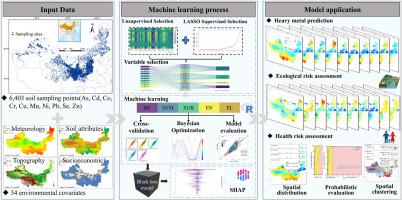Integrating Machine Learning for Enhanced Spatial Prediction and Risk Assessment of Soil Heavy Metal(loid)s
IF 7.3
2区 环境科学与生态学
Q1 ENVIRONMENTAL SCIENCES
引用次数: 0
Abstract
Accurately predicting the concentrations and spatial distribution of soil heavy metal(loid)s is crucial for effective environmental management and human health risk assessment. However, existing studies are often limited by poor model accuracy, feature selection, and interpretability—particularly under high-dimensional heterogeneous conditions that are inappropriate for more generalised traditional methods. This study proposes an integrated predictive framework combining unsupervised and LASSO-based variable selection, a Lasso-Stacking ensemble model, and SHAP-based interpretability analysis. Using 6,403 soil samples and 34 environmental variables from the arid region of northern China, high-resolution spatial predictions were conducted for 10 heavy metal(loid)s—As, Cd, Co, Cr, Cu, Mn, Ni, Pb, Se, and Zn—alongside ecological and human health risk assessments. The ensemble model significantly outperformed conventional machine learning models, achieving improved prediction accuracy (R2 > 0.6) and generalisability. Key environmental drivers influencing the distribution of heavy metal(loid)s included the aridity index, relative humidity, total phosphorus, and bulk density. Spatial analysis revealed that the southern Guanzhong Plain (in Shaanxi) and southern Gansu are hotspots for heavy metal(loid)s, likely affected by both natural and anthropogenic factors. The ecological risk assessment indicated widespread mild contamination by Cd, Se, Pb, and Cu. The health risk analysis revealed high non-carcinogenic risks associated with As, Cr, and Mn in children, and As, Cr, and Ni in both children and adults. This study provides an empirically sound framework for assessing soil pollution risks and supporting targeted environmental management strategies in northern China.

基于机器学习的土壤重金属空间预测与风险评估
准确预测土壤重金属的浓度和空间分布对有效的环境管理和人类健康风险评估至关重要。然而,现有的研究往往受到模型精度差、特征选择和可解释性的限制,特别是在高维异构条件下,这些条件不适合更广义的传统方法。本研究提出了一个集成的预测框架,结合无监督和基于lasso的变量选择、Lasso-Stacking集成模型和基于shap的可解释性分析。利用中国北方干旱区6403份土壤样品和34个环境变量,对10种重金属(样态)s-As、Cd、Co、Cr、Cu、Mn、Ni、Pb、Se和zn进行了高分辨率空间预测,并进行了生态和人类健康风险评价。集成模型显著优于传统的机器学习模型,实现了更高的预测精度(R2 >;0.6)和通用性。影响土壤重金属分布的主要环境因子包括干旱指数、相对湿度、总磷和容重。空间分析表明,关中平原南部(陕西)和甘肃南部是重金属(样物质)的热点地区,可能受自然和人为因素的影响。生态风险评价显示,镉、硒、铅、铜污染范围广,污染程度较轻。健康风险分析显示,儿童中与砷、铬、锰相关的非致癌风险较高,儿童和成人中与砷、铬、镍相关的风险较高。该研究为评估中国北方土壤污染风险和支持有针对性的环境管理策略提供了一个经验完善的框架。
本文章由计算机程序翻译,如有差异,请以英文原文为准。
求助全文
约1分钟内获得全文
求助全文
来源期刊

Environmental Pollution
环境科学-环境科学
CiteScore
16.00
自引率
6.70%
发文量
2082
审稿时长
2.9 months
期刊介绍:
Environmental Pollution is an international peer-reviewed journal that publishes high-quality research papers and review articles covering all aspects of environmental pollution and its impacts on ecosystems and human health.
Subject areas include, but are not limited to:
• Sources and occurrences of pollutants that are clearly defined and measured in environmental compartments, food and food-related items, and human bodies;
• Interlinks between contaminant exposure and biological, ecological, and human health effects, including those of climate change;
• Contaminants of emerging concerns (including but not limited to antibiotic resistant microorganisms or genes, microplastics/nanoplastics, electronic wastes, light, and noise) and/or their biological, ecological, or human health effects;
• Laboratory and field studies on the remediation/mitigation of environmental pollution via new techniques and with clear links to biological, ecological, or human health effects;
• Modeling of pollution processes, patterns, or trends that is of clear environmental and/or human health interest;
• New techniques that measure and examine environmental occurrences, transport, behavior, and effects of pollutants within the environment or the laboratory, provided that they can be clearly used to address problems within regional or global environmental compartments.
 求助内容:
求助内容: 应助结果提醒方式:
应助结果提醒方式:


